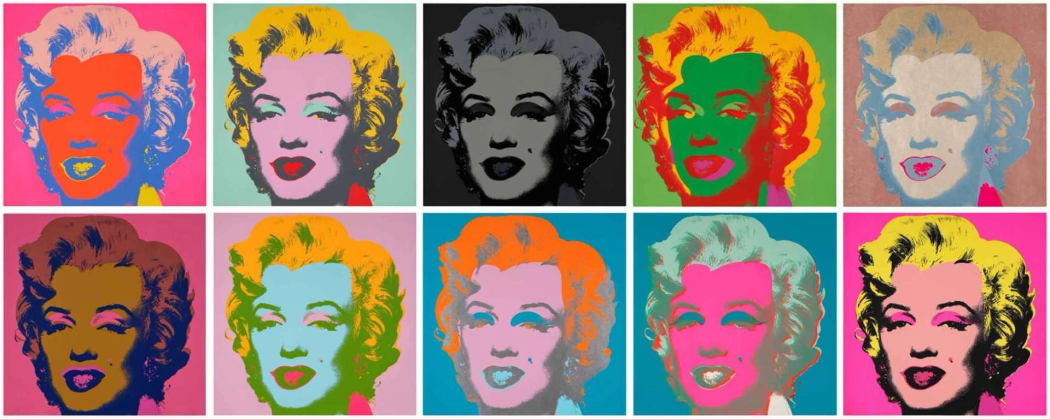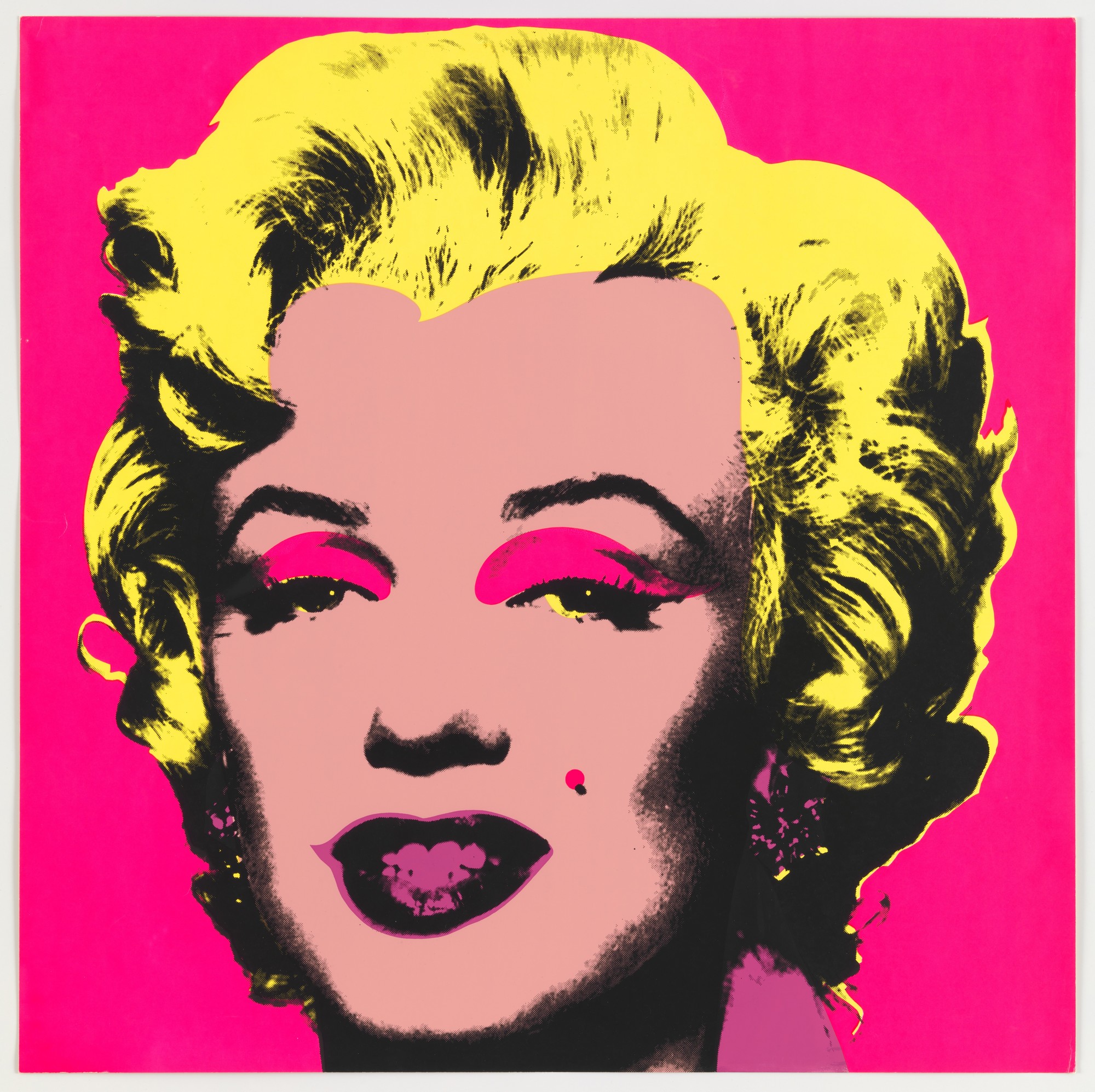
Feminist film theorist Laura Mulvey conceptualised the concept of the female gaze in the 1970s. The concept proposes that classical Hollywood films creates a lens for all audiences to identify a protagonist—usually male—driving all viewers, regardless of background, to experience and identify with the (typically) male protagonist. Within Warhol’s output of portrait, we can see how he uses the female figure - famous, exotic and iconic - to take the concept of female empowerment and place them, quite literally, at the heart of the work controlling the narrative that the viewer projects on to them.
With an almost insatiable appetite for pop culture, Warhol almost instinctively latched on to and curated the cultural zeitgeist of his time, Magazines would be a endless source of inspiration where he would find the subjects that he so voraciously contorted, coloured and reproduced with such aplomb. His ability to show a face or object across his working life that still have such an impact, is a testament to his keen-eye.
Regardless of the subject chosen, Warhol’s uncanny ability to remove the superfluous from an image leaving an almost undiluted, distilled and impactful form makes the works feel fresh some 50 years later. His principal choice of female figure can be characterised not just by their grace and beauty but also by their fame. Indeed, one could almost be of the persuasion that Warhol was able to use fame as a tool of fame through the women he so clearly idolised.
During the early 1960s, while living and working in New York, Warhol began to create his celebrity portraits. Using tabloid photographs or publicity shots for his screen prints, Warhol produced an impressive number of celebrity portraits, including Elvis Presley, Elizabeth Taylor, Jackie Kennedy and Marylin Monroe, who was Warhol’s first silkscreen-print subject. Following the actress’s untimely death in 1962, Warhol began to reproduce her portrait, which is based on a photograph from 1953 taken by Gene Kornman for the promotion of the film Niagara.
Whilst overtime Wahol expanded his subject matter, his obsession with fame and celebrity endured as he continued to produce celebrity portraits in the later part of his career, including Judy Garland, Debbie Harry and Dolly Parton.
A certain sensation of deification persists in his presentation of the female figures as cold, eerie shadows stare from the works as frozen in time, the celebrities become not just icons in the influential meaning but also in the religious connotations of the word.
The subjects are captured perfectly - with plump lips and slicked back hair, coy or more intense gazes abound -prime examples of the upheld standards of beauty by, not just Warhol’s society, but of many since. Three prime examples of Warhol’s women can be found in three of his most endearing images: Grace Kelly, Kimiko and, of course, Marilyn Monroe.
Created as a commission in 1984 as a fundraiser for the ICA, in Pennsylvania (her parents were active participants in the university community, making the dedication of this artwork very sentimental.) the artwork is an ode to Hollywood glamour and befitting of her later title as the Princess of Monaco. Warhol’s portrait enhances Kelly’s natural elegance through the use of flattering line and shadow. The TP, available at Andipa Editions, further shows Warhol's innate instinct for colour with soft, complimenting pastel tones punctuated by vivid, neon colours.

Created in 1981 Kimiko was another commission born out of the friendship between the subject and the artist. Kimiko Powers and her late husband amassed one of the largest private collections of pop art and Kimiko herself served as the muse for a number of Warhol works. Remembering Warhol’s visit to their apartment to take Polaroids in preparation for the commission, Kimiko recalled how they selected the photograph to be used for the portrait:
“And he said to me ‘Turn your face up. Turn your face to the side. Oh, it’s beauti… oh gee that’s great.’ He took Polaroids, one after another. Afterwards when we were finished, he put them all over the floor and asked, ‘Which one do you like?’ I said, ‘You’re the artist, you decide.’ But then I saw some that I didn’t like, so I said, ‘Andy I don’t think those are very nice. So please don’t use them.’”
Elegant and striking, the sky blue background of the piece is punctuated by shadow line and the fetching green colour of her traditional comodo - her soft peach colour extenuating her impassive gaze. Deeply personal both contextually and in style, the work can be read as examining the relationship and bond between the collector and the artist. Unlike the other subjects covered who were more public and famous figures, Warhol’s interest in commodification and financial success can be seen in the work that uses a wealthy individual as the subject.

Arguably one of the defining works of Warhol’s career, Warhol created the Marilyn portfolio just five years after Monroe’s suicide in 1962. Noting that most of her posthumous fame examined her drug overdose and portrayed her as a tragic figure - Warhol took interest in how her fame continued to evolve. Captured in a lively and vibrant manner, Warhol subverts the notion of the tragic figure and allows the beauty and power of the actress to take centre stage immortalising her forever.
Ultimately, the Marilyn Monroe portfolio is, in every way, a defining series for Andy Warhol. The depiction of Monroe as a symbol of celebrity life reflects some of the most provocative ideas in Warhol’s artistic philosophy. The repetitive nature of the series, which Warhol mass-produced at the Factory, suggests the commodification of Monroe’s infamous personality. He prints Monroe the same way he prints Campbell’s Soup, as an object of consumption. Aesthetically, the style defines the ultimate standard of Pop Art. The portraits’ fame and cultural purchase reflect Warhol’s deepest aspirations and contributions to our understanding of what art is.

For more information about our Andy Warhol original screenprint for sale, contact Andipa Editions via sales@andipa.com or call +44 (0)20 7589 2371.
Discover more on Warhol in our article how to authenticate a Warhol print.